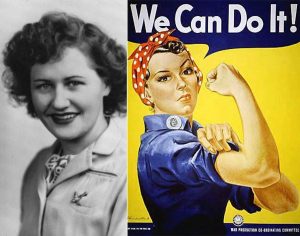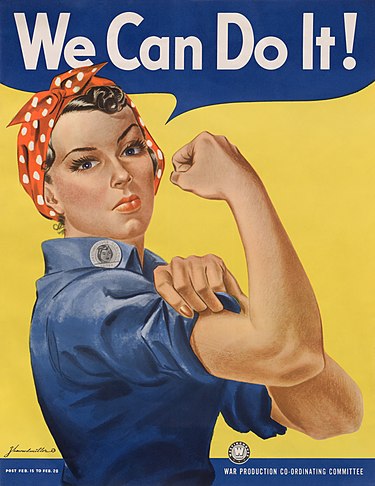The “Rosie the Riveter Poster” of 1942 is an enduring emblem of a pivotal juncture in American history, encapsulating the profound transformation that swept the nation during World War II. This iconic image reflects the dual challenges of global warfare and the redefinition of gender roles, particularly women’s unprecedented participation in the workforce. The roots of this piece are firmly planted in the wartime context of the early 1940s when the United States grappled with monumental social and economic shifts triggered by the outbreak of World War II.
To address the significant workforce void left by the millions of men drafted into the military, the government launched campaigns encouraging women to step into roles traditionally reserved for men (Pennington, 2006). “Rosie the Riveter” emerged as a poignant symbol of this historical pivot, portraying a committed, competent, and self-reliant woman ready to tackle the challenges of wartime production. The slogan, “We Can Do It!” emblazoned below her, resonates with empowerment and determination, serving as a clarion call for women to take on their newfound roles with unwavering confidence (Honey, 1984)
This poster’s historical significance is closely intertwined with the broader context of World War II, during which women’s roles underwent a dramatic redefinition. Traditionally confined to domestic spheres, women now found themselves crucial to the functioning of the American economy as men departed for the frontlines (Collins, 2009). Rosie the Riveter personifies this transition, challenging societal norms and conventions. In addition, the visual elements of the poster have been meticulously crafted to deliver its message effectively. Rosie’s image embodies resilience, determination, and strength. Her attire, complete with a polka-dotted bandana, mirrors that of a working woman while evoking a profound sense of patriotism. The red bandana pays homage to the American flag, and the predominantly red, white, and blue color palette underscores the connection to national pride (Gluck, 1987). The visual composition further underscores Rosie’s robust physique, confidently flexing her bicep and embracing the demands of her role as a riveter. Her sleeves rolled up, and the tools in the background emphasized her readiness to tackle arduous tasks. This depiction of women as capable and dedicated laborers represents a stark departure from conventional gender norms, challenging long-held stereotypes and fostering a more inclusive outlook (Weatherford, 2018). Moreover, it is crucial to acknowledge the creator of this iconic poster. J. Howard Miller, an artist working for Westinghouse Electric, designed the image, and it was initially displayed as part of a series to boost employee morale and productivity (Kimble, 1995).
The “Rosie the Riveter Poster” stands as a testament to the adaptability and resilience of American society during a time of crisis. It dispelled the notion that women could not handle labor-intensive jobs and marked a watershed moment in the annals of women’s rights. The image swiftly evolved into an enduring symbol of female strength and determination during the conflict, transcending its initial purpose.
All in all, the “Rosie the Riveter Poster” is a pivotal historical artifact that captures a profound moment of change in American history. It serves as a poignant reminder of the World War II era when women boldly seized the reins of the American workforce. This poster symbolizes their empowerment and courageous challenge to traditional gender roles, embodying the spirit of unity and resilience in the face of adversity. The legacy of Rosie the Riveter continues to inspire, a living testament to the transformative power of women during wartime and beyond.

References
Collins, Gail. “When Everything Changed: The Amazing Journey of American Women, from 1960 to the Present.” Google Books, June 4, 2014. https://books.google.com/books/about/When_Everything_Changed.html?id=76mfAQAACAAJ.
“Creating Rosie the Riveter : Class, Gender, and Propaganda during World War II : Honey, Maureen, 1945- : Free Download, Borrow, and Streaming.” Internet Archive, January 1, 1984. https://archive.org/details/creatingrosieriv0000hone.
Rosie the riveter revisited: Women, the war, and social change. Accessed November 17, 2023. https://www.tandfonline.com/doi/abs/10.1093/ohr/15.2.186.
“Rosie the Riveter: Women Working on the Home Front in World War II.” Rosie the Riveter: Women Working on the Home Front in World War II | Gender and War since 1600. Accessed November 17, 2023. https://gwonline.unc.edu/node/918.
